About Mount Kailash Parvat
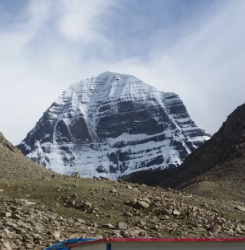
The River of the Lion Mouth to the North, the River of the Horse Mouth to the east, the River of the Peacock Mouth to the south and the River of the Elephant Mouth to the West. Strangely enough, four major rivers do indeed originate near Kailash, the Indus, the Yarlung Tsangpo (Brahmaputra), the Karnali and the Sutlej. Tibetans believe that it is the residence of Demchog, a fierce looking tantric deity who lives there with his consort, Dorje Phagmo. For the Tibetans also, it is a particularly special place in that their poet saint Milarepa, spent several years here meditating in a cave.
For the Hindus Mount Kailash is the earthly manifestation of Mt. Meru, their spiritual centre of the universe, described as a fantastic world pillar 84,000 miles high, around which all else revolves, its roots in the lowest hell and its summit kissing the heavens. On the top lives their most revered God, Shiva, and his consort Parvati.
For the Jains, an Indian religious group, Kailash is the site where their first prophet achieved enlightenment. For the older, more ancient religion of Bon, it is the site where its founder Shanrab is said to have descended from heaven. It was formerly the spiritual centre of Zhang Zung, the ancient Bon Empire that once included all of western Tibet. Bon people walk around the mountain in a counter clockwise manner, unlike the other religions.
Over the centuries pilgrims have constantly journeyed immense distances to achieve enlightenment or cleanse themselves of sin, braving enormous distances, particularly harsh weather and bandit attacks.
Important Places of Interest near Holy Mt. Kailash and Lake Mansarovar
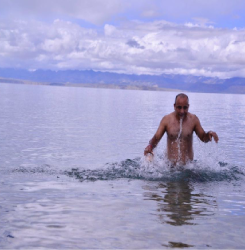
MANASAROVAR LAKE
Lake Manasarovar situated about 2000 kms from Lhasa is world’s highest freshwater lake. Mount Kailash ParvatKnown as Lake Manas Sarovar in Sanskrit and Mapham Yutso in Tibetan this huge lake with the mirror like image of snow capped mountains in its crystal clear waters is just fabulous. The lake is located at the southern foot of Mount Kailash, stretching up to 55miles (88kms) in perimeter it goes 330 feet deep and about 120 sq mi of total area. Lake Manasarovar has exceptional beauty that varies from crystal clear blue water near the shores and a deep emerald green colour at the center. There are a few monasteries on the shore of the lake and most striking of all is the ancient Chiu Gompa Monastery, which has been built right onto a steep hill.
This holy lake is one of the important pilgrimages for Hindus and Buddhists. It attracts thousands of tourists and religious people towards itself every year from various parts of the world, but mainly from India, Tibet and its neighboring countries. The best to visit the lake is during springs as it is during this time the lake melts and allows people to bathe in its holy water. As believed by bathing and drinking this water one becomes fortunate and clears all his sins. Many travel agencies have annual pilgrimage group tours to this place and are often known as “Manasarovar Yatra”.
Read More
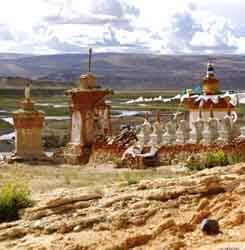
Tirthapuri
Tirthapuri, positioned northwest of Mount Kailash in Western Tibet are intimately associated with Padmasambhava (Guru Rinpoche). It is one of the interesting places near Kailash, pilgrims particularly come here after completing their kailash pilgrimage. They bathe in the pools fed by the holy springs and also pay a visit to the cave and monastery which is connected with Guru Pinpoche and has his footprints. The barren landscape around the Tirthapuri hot spring is filled with steam and colorful prayer flags stretched across the river gorge makes this spot a scenic & magical view for all.
Read More
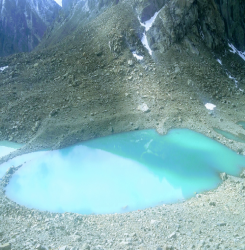
Gauri Kund
Gauri Kund, a water body that is also known as the Lake of Compassion, lies on the way while going on downwards from Dolma - La (Dolma Pass). This steep descent from Dolma Pass is a wonderful lake which is at an altitude of 5608m. As per Hindu mythology, there is a fascinating tale about Gauri Kund and has been described in legend “Shiva Purana”. The lake is also famous as “Parvati Sarovar” as this was the place where goddess Parvati had acquired her son Ganesha (Elephant headed God). Goddess Parvati had formed an image of Ganesh from the soap lather on her body and breathed life into it. She placed Ganesha at the entrance of her home as her janitor to prevent anyone from entering while she was bathing. Now Lord Shiva happened to return at this point of time and was stopped by Ganesha. Offended by this disrespectful act from Ganesha, Lord Shiva cut off the boy's head. Pravati was grief-stricken by seeing it and insisted that the boy needs to be brought back to life. Lord Shiva took the head of a wandering elephant and placed it on the body and life was restored and Parvati had her son back.
Read More
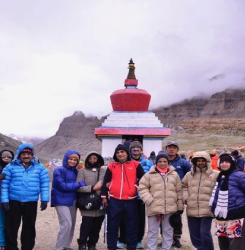
Yam Dwar
Yam Dwar is situated in Tarboche which is approximately 30 minutes drive from Darchen. The exact meaning of the Yam Dwar in Hindi lingo is “the gateway of the God of Death”. It is the initial point of circumambulation of Mount Kailash. Known as Chorten Kang Ngyi which means two legged Stupa in Tibet.
Read More
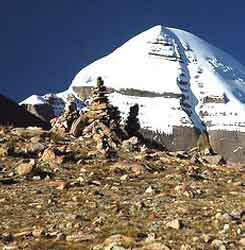
Asthapad
Located at a height of 17000 ft, Asthapad is the bottom of Mt. Kailash and one of the main holy places for the Hindus and Buddhists. It is also considered a major Jain Tirths as the first of the 24 Jain Tirthankara “Shri Adinath Bhagwan” had attained salvation (Nirvana) at this place. The literal meaning of SiwasthalAsthapad is “Eight Steps” as Astha means Eight and Pad means Steps in Sanskrit and that’s how the place derived its name.
Read More
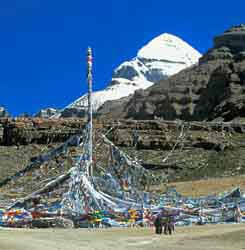
Siwasthal
Just around 2 hours walk from Deraphuk Gomba situated on the way to Dolma – La is Siwastal. Many pilgrims visit this place as it is known a duplication of the magical funeral ground at Bodh Gaya. Pilgrims here experience ritual death and enter into the dreadful presence of Yama, before being reborn on top of the Drolma La. One can easily notice the ground which is laid out with unbelievable collection of clothing, shoes, and bags along with terrible things like bones, hair and even blood. These things are mainly the offerings which are made by the people who pass from here. Above the burial ground is a red foot print of Milareppa (Tibetan yogi & poet) on the surface of a rock.
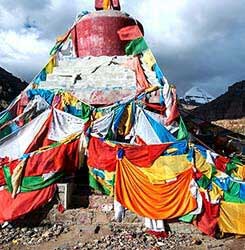
Tarboche
Tarboche flagpole, is one of the most important aspect of Tibetan spirituality. On “Saga Dawa” Tarbochewhich is an impressive and capturing annual festival of Mt. Kailash this giant flagpole which has numerous prayer flags on it is brought down and replaced. This annual festival or one can also mention it as a carnival attracts Tibetans from all over along with other tourists and pilgrims. This ritual is performed every year on the full moon day of the fourth lunar month of the Tibetan calendar, to celebrate Sakyamuni's enlightenment”. During the flagpole ceremony as the poles tip is raised and pointed east towards Gyangdrak Monastery, monks of that monastery carry out a special ritual. A cacophony of music from long trumpets, conch shells and other instruments welcomes the rising flagpole. It is like a magical event that captures one’s senses. People gathered there attach there prayer flags and help in making the pole rise again. The flagpole should be standing in a perfect upright position or it is believed that things will not be good for Tibet.











